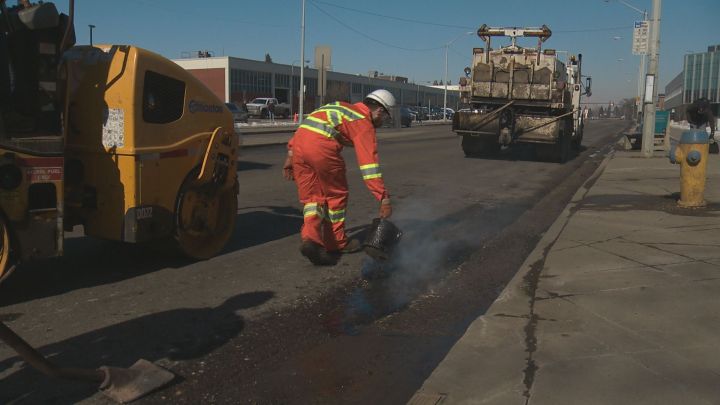Usually by now, Edmonton drivers would be well versed in how teeth-rattling potholes have impacted their drive to and from work.

This year, things have been delayed. That’s because of the four weeks that ended up being the coldest February weather stretch Edmonton has seen in 40 years. If any good news can be taken from that, it’s that pothole season has been delayed.
Numbers so far in 2019 are down, said Eduardo Sosa, the director of infrastructure maintenance for the city, but that’s only because the freeze/thaw cycle has been delayed. In the first two months of 2019, city crews have tackled roughly 10,000 potholes.
“Actually, having drier roads helped us to fix some of the potholes without too many being created because the temperatures stayed way below zero.”
Now that it’s usually a few degrees below zero when you wake up in the morning, and the city is hitting plus temperatures in the single digits during the day, Sosa expects to see a “normal” amount of potholes sprouting right about now.

Get daily National news
“That’s why I say this year is normal because that relates to the same amount that we had last year.”
Watch below: February 2019 was the coldest February Edmonton has experienced in 40 years

Another thing going in the city’s favour is the annual effort to have construction crews hit the streets to do “grind and pave” work, where the top strip of asphalt is taken away, and replaced with a new layer.
That work can extend the lifespan or a road by 10 to 15 years, and Sosa said it helps reduce the number of potholes they have to deal with.
“The tighter the road is, then the less water gets into the road surface. By keeping the water outside, because they are newer roads, then potholes are not created.”
Potholes are created when a crack forms in the pavement, water gets in and freezes, expanding the crack and eventually the asphalt wears out and a pothole shows up.
Technology is helping the city keep up. The 311 app has a feature where you can shoot a picture and pass it along. That way crews know exactly what you’re talking about. Calling 311 is considered the second-best option.
In 2018, crews repaired 423,918 potholes. This is an average of 1,100 per day based on ideal weather conditions. In 2017, crews repaired 419,341 potholes. Sosa expects they’ll approach half-a-million again this year.
To help keep on top of things, the city has its own asphalt plant. They create both a mix for cold asphalt and hot. The product they produce seems to get better every year. Of what they produce, “hot seems to be the best one, just because of how it behaves,” Sosa said.






Comments